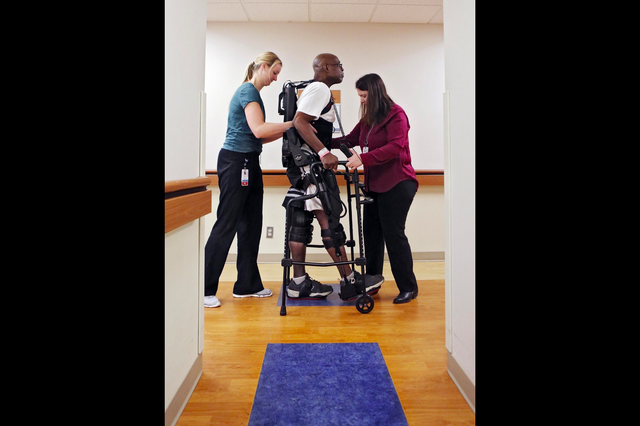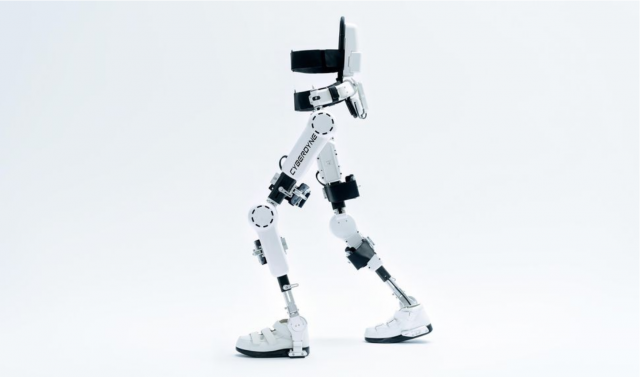

Imagine the feeling of giving someone back their ability to walk, to run, to jump and to climb after they had lost it or potentially never really had these abilities in the first place...
Wouldn't it be amazing to be able to give someone the gift of mobility again after they had lost it?
We often take things like the ability to walk or run for granted. Many of us simply achieved this ability at a young age and never gave it a second thought about what a gift it truly is...
In this article I will discuss the technological improvements made in the field of exoskeleton technology as of late. We have entered a new age in which robotic exoskeletons are being used to help patients learn to walk again. They are being used in the workplace to give workers relief in factory and warehouse jobs and other applications that are still being developed.
One of the most useful application for this technology was described in an article I recently read entitled 'Robotic exoskeleton helps patients learn to walk again' published by The Columbus Dispatch in early March 2018.
This article featured a man named David Evans who had lost his ability to walk although admittedly he had no doubt as to whether he would ever be able to walk again. The determination was there, he just needed a bit of help to reach his goal.
In November 2017 David woke up in a hospital unable to move his legs. In March thanks to the help of a new high tech exoskeleton model he was already making progress in rehabilitating his ability to walk again.
David Evans moved slowly and deliberately down a hallway at the OhioHealth Rehabilitation Hospital, getting help not just from physical therapists but also from a new robotic device designed to give him the support and assistance needed to take step after step after step. The February session marked just the second time Evans had walked since the November morning he awoke unable to move his legs.
“They asked me what my goal was when I left here, and I said ‘to regain the use of my legs.’ So it’s gonna happen,” Evans said as he sat in a wheelchair after the exoskeleton was removed. “This machine has helped me.”
Evans is just a single example of someone exoskeleton technology has helped. Their usefulness in rehabilitating patients who have lost their ability to walk can't be praised enough.


Image Source: Eric Albrecht / Dispatch

In fact rehabilitation centers in the United States will be getting an upgrade this year. Japan's long-awaited Cyberdyne exoskeleton legs capable of bringing back mobility to patients who have lost their ability to walk have finally been approved for patients in the United States.
Apparently the Cyberdyne HAL wearable robotic exoskeleton has been available for nearly a decade. However, it takes a long time to get medical procedures and new devices approved in the United States so there is quite a bit of red tape holding back progress in different sectors of healthcare.
According to Cyberdyne the HAL is essentially a pair of legs exclusively approved for temporary medical use. What this means is that the device isn't made for people who are totally paralyzed, they're for rehabilitation.
Today, the Japanese company's mechanical legs are officially available at the new Brooks Cybernic Treatment Center in Jacksonville, Florida -- with plans to bring the FDA-approved device to spinal cord injury patients at hospitals across the US.
The "Medical HAL" gained approval from the FDA last December, but there hasn't been an official statement as to how much the device will cost yet. "As with any new technology just entering the market, HAL initially is unlikely to be covered by insurance. We are working to determine final pricing and will discuss that with each program participant," a Brooks representative reported.
It is difficult for me to explain just how amazing this new exoskeleton really is so it seems like a better idea to just show you what I'm talking about. Take a look at the video below to see for yourself!


So now that I've educated my readers a bit about how exoskeletons are being used for rehabilitation, lets take a look at another application. How do you imagine they could be used to help workers complete their tasks?
I recently read an article by The Drive entitled 'Ford Is Equipping Valencia Factory Workers With Exoskeletons.' This was a very interesting article focused around how Ford was testing out the use of exoskeletons with their workforce in an effort to increase productivity and reduce the typical pains an employee may experience while working on a factory floor.
This article was written in Feb. 2018 so the information presented is still quite current in regard to the happenings with exoskeleton technology going on right now in our world.
Ford began its evaluation of augmentations for assembly line workers last year when it trialled the "EksoVest" upper body industrial exoskeleton on laborers in in two of the company's U.S. factories. The American automaker announced Friday that its exoskeleton program has been fully implemented in its Valencia factory in Spain with nine rigs of carbon fiber and titanium deployed at present and another twenty employees slated to try out the exoskeletons in April.
So, what interests me most about this news is why Ford is doing this. What are they hoping to achieve by having their employees test this technology out?
"Ford currently uses two different types of exoskeleton at the plant in Valencia, supplied to Ford by outside companies," a Ford Europe spokesperson said. "The units augment the user's physical endurance rather than strength, as tasks in the plant involving heavier or bulk items are handled by robots or machinery."
So clearly they are very motivated and interested in applying this technology in their operations. I say that because of the fact that they are testing more than one type of exoskeleton at the moment which makes it look like less of a fad and more like a proper study.
Furthermore, we can learn from the quote above that the company has interest in augmenting a user's physical endurance (what this means is they'd like to give their employees to work harder and longer).


Image Source: Cyberdyne

Hopefully I've got you interested in this topic now and if I'm right, you'll want to know what the outcome of this Ford exoskeleton study was and what it means for the future...
Well, even if I haven't got you incredibly interested, too bad, I'm going to tell you anyway!
Unfortunately, Ford's spokesperson declared that the company was not able to quantify a productivity increase. This doesn't mean necessarily that one doesn't exist, it just means that based on their study they weren't able to reproduce a data set that confirmed this truly was the case. On a brighter note, the spokesperson said that the company did find that employees seemed to benefit from less fatigue after a shift. They also narrowed down their results and found that the age of employees benefiting from the exoskeletons was focused in a range from 30 to beyond 50.
“My job can be like a workout at the gym and you really need to be fit to tackle some of the tasks," stated 34-year-old Ramón Navarrete of the Valencia plant in Ford's release. "The exoskeleton suit makes a big difference and at the end of a shift I feel much fresher.”
One thing is certain and that is the fact that exoskeletons are becoming more commonly used in fields ranging from healthcare to manufacturing so be prepared to see a lot more of this technology in the coming years and decades!
What do you think about the sucess story mentioned above about David Evans? Do you think exoskeleton technology can be a good replacement for a physical therapist? How do you feel about the technology being applied to factory and warehouse jobs? Do you think exoskeleton technology will advance a lot in the coming years?
Thanks for reading.
Authored by: @techblogger
In-text citations sources:
"Robotic exoskeleton helps patients learn to walk again." - The Columbus Dispatch
"Japan's long-awaited exoskeleton legs could help you walk again" - CNET
"Ford Is Equipping Valencia Factory Workers With Exoskeletons" - The Drive
Image Sources:
Cyberdyne, The Drive, The Guardian
I think its great that technology has advanced to the point of helping people regain there freedom and independents. Just what worrys me is when big corps. use robotics to cut down on staff. Technological Reveolution is ever so evolving. Nice post!
Downvoting a post can decrease pending rewards and make it less visible. Common reasons:
Submit
Good post keep it up.
Downvoting a post can decrease pending rewards and make it less visible. Common reasons:
Submit